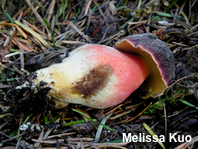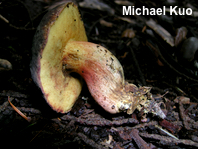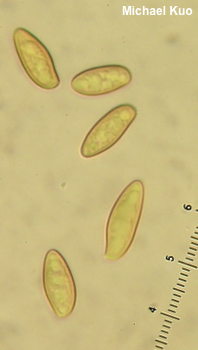| Major Groups > Boletes > Xerocomellus atropurpureus |

|
[ Basidiomycota > Boletales > Boletaceae > Xerocomellus . . . ] Xerocomellus atropurpureus by Michael Kuo, 1 April 2024 One of two phylogenetic species from western North America that used to be called "Boletus zelleri," Xerocomellus atropurpureus is gorgeous when young and fresh, featuring a dark brown cap, a red and yellow stem, and a yellow pore surface. With age, it begins to lose some of its pizzazz, but still retains much of its original glory. Separating Xerocomellus atropurpureus from Description: Ecology: Mycorrhizal with conifers; growing alone, scattered, or gregariously; fall and winter; originally described from Oregon (Frank et al. 2020); distributed in the Pacific Northwest and northern California, and in the Sierra Nevada and Cascade ranges. The illustrated and described collections are from California. Cap: 4–9 cm; convex, becoming broadly convex; dry; often tightly wrinkled when young; bald or, when young, with a whitish bloom; sometimes developing fissures in age, but not typically becoming finely cracked; dark brown to nearly black, often with reddish to purplish hues. Pore Surface: Yellow when young, becoming olive yellow; not bruising, or bruising slowly bluish gray to brownish; with 1–2 angular pores per mm; tubes to 6 mm deep. Stem: 4–7 cm long; 0.5–2 cm thick; at first swollen centrally or basally, but more or less equal with age; solid; red overall, or yellow (especially apically) with red areas; sometimes bluing slowly when bruised; basal mycelium yellowish. Flesh: Whitish to yellowish in cap; yellowish to yellow in stem; not staining when sliced, or staining slowly and erratically bluish. Odor and Taste: Not distinctive. Chemical Reactions: Ammonia negative on cap and flesh. KOH negative to grayish on cap; orangish to dark yellow on flesh. Iron salts negative on cap and flesh. Spore Print: Olive brown. Microscopic Features: Spores 12–16 x 4–6 µm; boletoid-fusiform; smooth; yellowish to golden in KOH; inamyloid. Basidia 35–38 x 5–8 µm; clavate; mostly 4-sterigmate. Hymenial cystidia not found. Pileipellis a trichoderm or palisadoderm; elements 4–15 µm wide, subglobose to ellipsoid or elongated-cylindric; smooth or a little encrusted; yellowish to brownish in KOH; terminal cells varying (sometimes within the same cap) from cylindric-elongated with apices subclavate or merely rounded, to subglobose, ellipsoid, or awl-shaped. REFERENCES: J. L. Frank, N. Siegel, & C. F. Schwarz, 2020. (Smith, 1949; Thiers, 1975; Smith, Smith & Weber, 1981; Phillips, 1991/2005; Schalkwijk-Barendsen, 1991; Lincoff, 1992; Both, 1993; Bessette, Roody & Bessette, 2000; Miller & Miller, 2006; Kuo, 2007; Trudell & Ammirati, 2009; Siegel & Schwarz, 2015; Frank et al., 2020.) Herb. Kuo 01130509, 01141501. This site contains no information about the edibility or toxicity of mushrooms. |
© MushroomExpert.Com |
|
Cite this page as: Kuo, M. (2024, April). Xerocomellus atropurpureus. Retrieved from the MushroomExpert.Com Web site: http://www.mushroomexpert.com/xerocomellus_atropurpureus.html |


